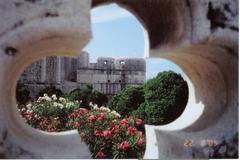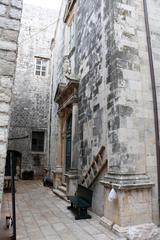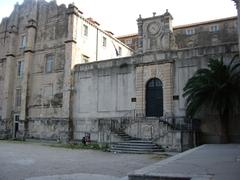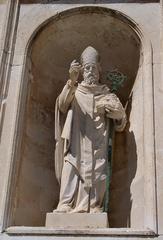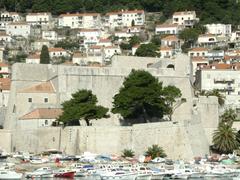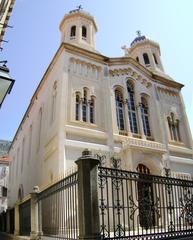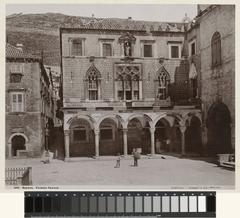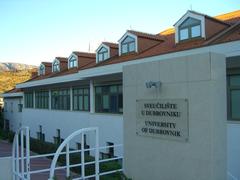St. Saviour Church Dubrovnik: Visiting Hours, Tickets & Travel Guide
Date: 04/07/2025
Introduction
St. Saviour Church (Crkva Svetog Spasa) is one of Dubrovnik’s most treasured historical sites, renowned for its blend of Renaissance and Gothic architecture and its remarkable story of resilience. Located just inside the iconic Pile Gate at the threshold of Dubrovnik’s UNESCO-listed Old Town, the church stands as a living testament to the city’s communal spirit, faith, and cultural vibrancy. This detailed guide offers everything you need to know for your visit: from historical context and architectural highlights to practical information on opening hours, tickets, accessibility, and nearby attractions.
Table of Contents
- Historical Significance & Origins
- Architectural Features & Artistic Heritage
- Visiting Information
- Cultural and Community Role
- Nearby Attractions
- Tips for Visitors
- Frequently Asked Questions (FAQ)
- Preservation & Restoration
- Conclusion
- References and Further Reading
Historical Significance & Origins
The 1520 Earthquake and the Votive Promise
St. Saviour Church was conceived as a votive offering after the catastrophic earthquake that struck Dubrovnik on May 17, 1520, resulting in significant destruction and loss of life (TravelCurious). In gratitude for the city’s survival and divine protection, the Dubrovnik Senate resolved to construct a new church. This act of collective thanksgiving is immortalized in the Latin inscription over the entrance, serving as a lasting reminder of the city’s history and spirit (Absolute Croatia).
Patronage, Oversight, and Community Involvement
The Senate appointed three noblemen to oversee construction, ensuring transparency and public trust (Zelić, 2022). Designed by Petar Markov Andrijić, a master architect and stonemason from Korčula, the church’s creation was a community-wide effort. Local traditions tell of women from all social backgrounds who helped carry stones and prepare mortar, embodying Dubrovnik’s communal devotion (Absolute Croatia; tzdubrovnik.hr).
Architectural Features & Artistic Heritage
Renaissance-Gothic Fusion
Completed in 1534, St. Saviour Church is widely regarded as Dubrovnik’s first fully Renaissance-style building, yet it retains distinct Gothic features (Dubrovnik Travel). The façade showcases classical Renaissance pilasters and a semicircular apse, while the interior boasts a single nave, Gothic cross-ribbed vaulting, and pointed-arch windows (AA Architects; TravelCurious). Constructed from local limestone, the church harmonizes visually with the city’s other historic monuments.
Symbolic Elements
Above the entrance, a monumental Latin inscription commemorates the church’s founding as an act of gratitude for deliverance from the 1520 earthquake (AA Architects). The harmonious blend of Renaissance clarity, Gothic structure, and the symbolic trefoil roof make the church an architectural gem and a testament to Dubrovnik’s artistic legacy.
Visiting Information
Opening Hours & Entry
- Summer (April–October): 9:00 AM – 6:00 PM
- Winter (November–March): 9:00 AM – 4:00 PM
- Closed: Major public holidays and during special events
Admission is free for individual visitors. Donations are welcome to support ongoing maintenance and restoration. Entry may be restricted during concerts, religious services, or private events (tzdubrovnik.hr).
Accessibility
- Ground-level entry makes the church accessible to those with limited mobility.
- Some areas inside may be narrow or uneven due to the historic structure.
- The Old Town’s cobblestone streets may present challenges for wheelchairs and strollers.
Dress Code & Visitor Etiquette
- Dress modestly: cover shoulders and knees, and remove hats upon entry.
- Maintain a respectful silence, especially during religious services or concerts.
- No eating or drinking inside the church.
Photography
- Non-flash photography is generally allowed.
- Respect restrictions during services and events—look for posted notices or guidance from staff.
Getting There
- Location: Just inside Pile Gate, behind Onofrio’s Fountain, at the start of Stradun.
- Transport: Public buses stop at Pile Gate. Taxis can drop you near the entrance, but vehicles are not permitted inside city walls.
- On Foot: The church is among the first sights when entering Old Town.
Cultural and Community Role
Religious and Civic Functions
St. Saviour Church remains an active Roman Catholic place of worship, with regular Masses and opportunities for quiet reflection (TravelCurious). Its history as a votive church reinforces its role as a civic monument and spiritual center.
Concerts & Events
The church is renowned for its acoustics, making it a favored venue for chamber music concerts, particularly during the Dubrovnik Summer Festival (Dubrovnik Calendar of Events; Dubrovnik Summer Festival). Tickets for concerts can be purchased in advance through the festival’s website or tourist offices.
Nearby Attractions
- Franciscan Monastery: Right next door, home to Europe’s oldest working pharmacy.
- Onofrio’s Fountain: A 15th-century landmark and popular meeting point.
- Dubrovnik City Walls: A short walk away, offering panoramic views of the Old Town.
- Stradun: The city’s vibrant main pedestrian street, lined with shops and cafes.
- Rector’s Palace: Historic seat of government, now a museum.
Tips for Visitors
- Visit early in the morning or late afternoon to avoid crowds from cruise ships.
- Combine your visit with nearby attractions for an enriched itinerary.
- Bring a scarf or shawl for modesty and dress in layers—church interiors are cool even in summer.
- Comfortable, non-slip footwear is recommended for navigating Old Town’s polished limestone streets.
- Public restrooms are available near Pile Gate and along Stradun.
Frequently Asked Questions (FAQ)
Is there an entrance fee?
No, admission is free. Tickets are only required for special concerts or events.
What are the church’s visiting hours?
Typically 9:00 AM – 6:00 PM in summer and 9:00 AM – 4:00 PM in winter, but check official sources for updates (tzdubrovnik.hr).
Is the church wheelchair accessible?
The entrance is step-free, but the surrounding cobblestones and some interior areas may be challenging.
Can I take photos inside?
Yes, without flash, and with respect for services or events.
Are guided tours available?
Yes, the church is included in most Dubrovnik Old Town walking tours, which can be booked locally or online.
What else can I visit nearby?
The Franciscan Monastery, Onofrio’s Fountain, City Walls, Rector’s Palace, and Stradun are all within a short walk.
Preservation & Restoration
St. Saviour Church has survived centuries of earthquakes and wars, including the devastating 1667 earthquake and damage during the Croatian War of Independence (Dubrovnik Restoration). Restoration efforts by the Institute for the Restoration of Dubrovnik have prioritized authenticity, using local materials and advanced conservation methods. Ongoing maintenance is supported by public funds, donations, and the Diocese of Dubrovnik.
Conclusion
St. Saviour Church is more than a monument—it is a vibrant symbol of Dubrovnik’s resilience, faith, and communal pride. Its elegant architecture, storied history, and central location make it an essential stop for any visitor to the city. Whether you’re drawn by its historical significance, architectural beauty, or cultural events, St. Saviour Church offers a rewarding and memorable experience at the gateway to Dubrovnik’s Old Town.
For up-to-date visitor information, event schedules, and guided tours, consult the official Dubrovnik Tourist Board and the Dubrovnik Summer Festival websites. Enhance your visit with the Audiala app for guided audio tours and travel tips.
References and Further Reading
- St. Saviour Church Dubrovnik: History, Architecture, Visiting Hours, and Visitor Guide, Danko Zelić, 2022
- AA Architects: St. Saviour Church
- Cultural and Religious Importance of St. Saviour Church, GoDubrovnik & Live the World
- Dubrovnik Tourist Board: Visiting Hours, Tickets & Nearby Attractions
- Dubrovnik Summer Festival Official Site
- Dubrovnik Restoration and Conservation Efforts
- TravelCurious: St. Saviour Church Dubrovnik

